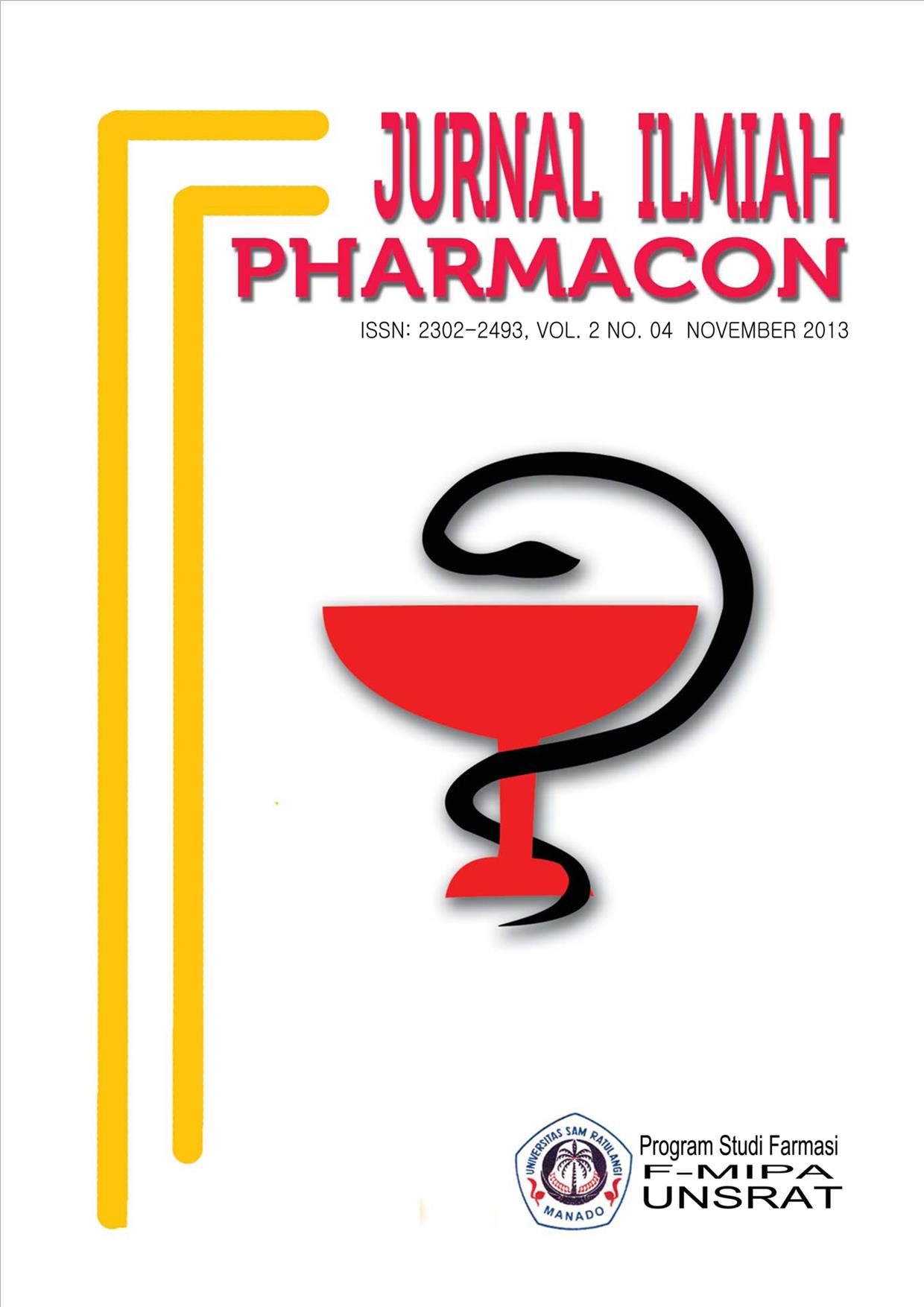STUDI PENGGUNAAN OBAT ANTIHIPERTENSI PADA PASIEN GAGAL GINJAL KRONIK YANG MENJALANI PERAWATAN DI RSUP PROF. DR. R. D. KANDOU MANADO PERIODE JULI 2013 - JUNI 2014
DOI:
https://doi.org/10.35799/pha.4.2015.8833Abstract
STUDI PENGGUNAAN OBAT ANTIHIPERTENSI PADA PASIEN GAGAL GINJAL KRONIK YANG MENJALANI PERAWATAN DI RSUP PROF. DR. R. D. KANDOU MANADO PERIODE JULI 2013 - JUNI 2014
Nur Rizkah Muchtar1) , Heedy Tjitrosantoso1), Widdhi Bodhi1)
1)Program Studi Farmasi FMIPA UNSRAT Manado, 95115
Â
ABSTRACT
Chronic kidney disease is progessive loss of kidney function that occurs months to years, which characterized with changes in the normal structure of kidney gradually. Hypertension is a trigger factor for acute kidney disease and chronic kidney disease, it can cause damage to blood vessels in kidney and decrease the kidneys ability for blood filtration. This study was aimed to determine the use of antihypertensive drugs for patient with chronic kidney disease that hospitalized at RSUP Prof. Dr. R. D. Kandou Manado during july 2013-june 2014.  This research is study with retrospective data aggregation for three months during October to December 2014 in medical record room at RSUP Prof Dr. R. D. Kandou Manado for 53 medical record of patient with chronic kidney disease which use antihypertension drugs. The result showed that antihypertension drugs are often used in single therapy group is Calsium Channel Blocker (CCB) group (58,3%), Diuretic group (33,3%) and Angiotensin Converting Enzyme Inhibitor (ACE-I) group (8,3%). Antihypertension drugs are often used for combination therapy group is combination between Diuretic and CCB group (27,6%), Diuretik dan ACE-I group (17,2%), and ARB and CCB group (13,8%) .
Â
Key Words : Chronic Kidney Disease, Antihypertension Drug, Single Therapy, Combination Therapy
ABSTRAK
Gagal ginjal kronik merupakan kehilangan fungsi ginjal progresif, yang terjadi berbulan-bulan sampai bertahun-tahun, yang di karakterisasi dengan perubahan struktur normal ginjal secara bertahap. Hipertensi merupakan faktor pemicu terjadinya penyakit ginjal akut serta penyakit ginjal kronis karena dapat menyebabkan kerusakan pembuluh darah dalam ginjal sehingga mengurangi kemampuan ginjal untuk memfiltrasi darah dengan baik. Penelitian ini bertujuan untuk mengetahui penggunaan obat antihipertensi bagi pasien gagal ginjal kronik yang menjalani perawatan di RSUP Prof Dr. R.D Kandou Manado periode juli 2013 – juni 2014. Pengumpulan data dilakukan secara retrospektif selama 3 bulan dari Oktober sampai Desember 2014 di ruang rekam medik di RSUP Prof Dr. R.D Kandou Manado. Penelitian ini dilakukan terhadap 53 catatan rekam medik penderita gagal ginjal kronik yang menerima Obat Antihipertensi. Hasil penelitian menujukkan Obat Antihipertensi yang sering digunakan pada kelompok terapi tunggal yaitu golongan Calsium Channel Blocker (CCB) (58,3%), golongan Diuretik (33,3%) dan golongan Angiotensin Converting Enzyme Inhibitor (ACE-I) (8,3%). Obat Antihipertensi yang sering digunakan pada terapi kombinasi yaitu kombinasi golongan Diuretik dan CCB (27,6%), golongan Diuretik dan ACE-I (17,2%), dan golongan ARB dan CCB (13,8%).
Â
Kata kunci : Gagal Ginjal Kronik, Obat Antihipertensi, Terapi Tunggal, Terapi Kombinasi
Â
Downloads
Published
How to Cite
Issue
Section
License
Authors who publish with this journal agree to the following terms:
- Authors retain copyright and grant the journal right of first publication with the work simultaneously licensed under a Creative Commons Attribution-NonCommercial 4.0 International License that allows others to share the work with an acknowledgement of the work's authorship and initial publication in this journal.
- Authors are permitted and encouraged to post their work online (e.g., in institutional repositories or on their website) prior to and during the submission process, as it can lead to productive exchanges, as well as earlier and greater citation of published work (See The Effect of Open Access)










